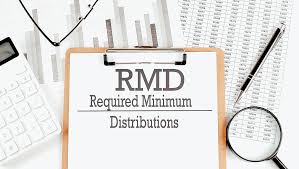Required Minimum Distributions (RMD)
October 25, 2023
 What is a Required Minimum Distributions (RMD)?
What is a Required Minimum Distributions (RMD)?
A required minimum distribution (RMD) is the minimum amount you must withdraw from your retirement account(s) each year to satisfy federal tax rules. Your RMD starts once you reach a certain age known as your required beginning date.
For IRA’s (other than Roth IRA’s)
Your required beginning date is April 1 of the year following the calendar year in which you reach your RMD Applicable Age. Subsequent RMD’s must be taken by 12/31 each year.
For Employer-Sponsored Retirement Plans
Your required beginning date is April 1 of the year following the calendar year in which you reach your RMD Applicable Age or retire from the plan sponsor, if later (unless you are a 5% owner of the business sponsoring the plan). Subsequent RMD’s must be taken by 12/31 each year.
When is My Required Beginning Date?
The required beginning date (RBD) is April 1 of the year following the year you turned:
- 70 1/2 if you were born before 7/1/49.
- 72 if you were born on or after 7/1/49 or in 1950.
- 73 if born between 1951 and 1958.
- 75 if born in 1960 or later.
If you were born in 1959, federal guidance is needed to determine if your Required Beginning Date is age 73 or 75. If you are concerned that you may have missed an RMD, please contact your tax advisor.
How is the RMD Calculated?
The amount is based on your account balance at the end of the previous year and, generally, the life expectancy factor provided by the IRS in the Uniform Lifetime Table. Your RMD will change every year based on those two numbers.
When Do I Neet to Take Money Out of MY Employer Sponsored Plans?
You generally must take a distribution each year from employer-sponsored plans, including 401(a), 401(k), 403(b), 457(b) and other defined contribution plans, when you reach your required beginning date (RBD) age or retire, whichever is later (plan permitting).
In the first year for which you are required to take RMD, you have two choices: You can take your first withdrawal (the amount required for the first year) in that year (e.g., 2023); or you can wait and take it in the next year (2024), as long as it is paid by April 1. However, if you wait until the next year to take your first withdrawal, you’ll have to take two withdrawals in that year—one for the amount required in the first year (2023) and one for the next year (2024)—which may increase your tax liability.
What About Roth Accounts?
Roth IRAs do not require withdrawals until after the death of the owner. Designated Roth accounts in a 401(k) or 403(b) plan are subject to the RMD rules for 2022 and 2023. However, for 2024 and later years, RMDs are no longer required from designated Roth accounts. You must still take RMDs from designated Roth accounts for 2023, including those with a required beginning date of April 1, 2024.
What if I Don’t Take the Required Amount?
There is a 25% excise tax on any amount that a taxpayer fails to take as a required minimum distribution (RMD). The 25% excise tax may be reduced to 10% if the missed RMD is corrected within a correction window as defined in Section 302 of SECURE 2.0.